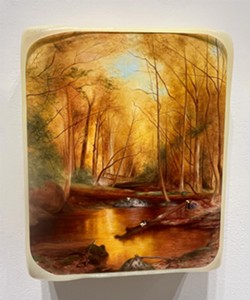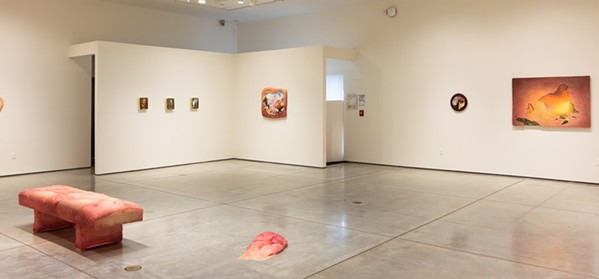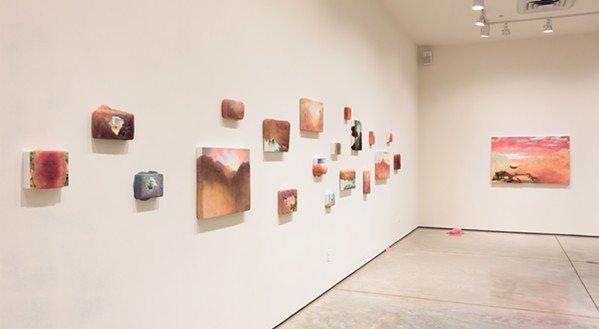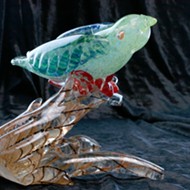Cobi Moules pulls 1980s horror films and landscapes together to put queer bodies in spaces that once limited them
By Camillia Lanham[{
"name": "Ad - Medium Rectangle CC01 - 300x250",
"id": "AdMediumRectangleCC01300x250",
"class": "inlineCenter",
"insertPoint": "8",
"component": "2963441",
"requiredCountToDisplay": "12"
},{
"name": "Ad - Medium Rectangle LC01 - 300x250",
"id": "AdMediumRectangleCC01300x250",
"class": "inlineCenter",
"insertPoint": "18",
"component": "2963441",
"requiredCountToDisplay": "22"
},{
"name": "Ad - Medium Rectangle LC09 - 300x250",
"id": "AdMediumRectangleLC09300x250",
"class": "inlineCenter",
"insertPoint": "28",
"component": "3252660",
"requiredCountToDisplay": "32"
}]
Ombre skin tones in fleshy silicon dripped down one corner of the Harold J. Miossi Gallery at Cuesta College, pooling on the floor, as if gathering itself together to make its next move.
Shades of that same material covered parts of ethereal oil-painted landscapes around the gallery, obscuring the view and often framing tiny, glittery jockstraps strewn about the natural world.
Cobi Moules said he sees the jockstraps as remnants of queer joy left behind on the landscape.
"There's something about this particular object, when you're wearing it or you're seeing someone wearing it, there's this sort of confidence and body positivity," Moules told New Times. "It reveals so much. ... Especially on a trans body. You just see the full body."
A body can't hide in a jockstrap, but it can be celebrated—and it is celebrated within queer spaces, Moules said. With that comes this feeling of community, acceptance, love, and body positivity in every form it could possibly take.
It's the opposite feeling of the paintings that serve as the backdrop for Moules' work and his exhibition, Showering of Sparkling Bits, that was up from Feb. 1 to March 15 at the Miossi Gallery. Landscape paintings from the Hudson River School art movement and painters from the 19th century have been a constant in the transmasculine artist's work. Moules repaints the works of artists like Albert Bierstadt, Frederic Church, and Thomas Cole—whose paintings he describes as focused on the relationship between God, nature, and the individual.
"It was the first European-American paintings that were really kind of focused in on America and American exceptionalism and moral authority, and specifically the ideas around the moral authority for conservative white Christians," Moules said. "They used these paintings as a way to perpetuate fear and degradation of the other."
Hudson River School paintings of iconic Western landscapes like Yellowstone and Yosemite idealized American identity, embracing religious ideology, controlling who could participate, and forcing someone like him to engage with the space in an extremely limited manner or not allowing him in at all, Moules said.
He grew up in a conservative Christian household in Central California, spending a lot of time outdoors. His family loved to camp and that wild landscape was what his grandmother taught him to paint.
"I think the landscape had always been a very important image growing up," he said. "The links between the ideologies in their work and the religion that I grew up with felt very tied."
So Moules doesn't simply repaint them. He makes them lighter and brighter to give them a less imposing and more welcoming feel. For years, he put multiples of himself into the images. But more recently, his work shifted away from his own personal narrative and body to something bigger. Moules started to play with silicon as a way to integrate the queer body into his work.
He was able to explore the new material and reimagine his art with the help of a materials stipend from the Harold J. Miossi Gallery, something that gallery Curator Timothy Stark said led to a full exhibition of original artwork created specifically the gallery. While previous stipends helped artists create original pieces for their exhibitions, it was the first show that was completely imagined for the Miossi Gallery space.
"It takes a lot of trust and belief that the artist is able to pull it off," Stark said. "But with Cobi it was never a question."
While the gallery serves the school and its students, Stark said it also aims to serve the artists who it brings in. Materials stipends are a way to support artists in their production and encourage creating art that's new, experimental, or different from their original work. Stark said he searches for artists who put out quality work with an important message, and Moules does both.
"I thought that he had a message surrounding and an introspective look at trans bodies that was really fascinating and was really nuanced and really important in the discussion about trans bodies and trans people that's going on right now," Stark said. "Quality plus message equals a major chance to have a really, really important exhibition."
Showering of Sparkling Bits was the most well-attended show since the Miossi Gallery reopened post-COVID-19, Stark added. Normally, shows average about 600 attendees. Moules' show brought in more than 1,000.
Moules said he couldn't have created the pieces without the gallery's help, adding that silicon is an expensive, difficult material to work with. He was drawn to the medium because of its texture. It's squishy with a real skin-like feel—similar to sex toys—and it's also reminiscent of the creatures from 1980s horror films, such as The Blob and The Stuff.
"I do think of the silicon as this kind of trans queer body, because it's fluid and malleable and nongendered, but it also has the moles and the veins and the pimples and sometimes hair coming out," Moules said. "With all of those details, it's this real figure with all of these bodily specificities, but it's fluid. ... It's able to alter and change itself and go as it pleases."
Drawing a parallel between the Hudson River School and the horror films he grew up watching, Moules said that both genres reflect the ideas of their time, which still exist today. In his artist's talk for the exhibit, Moules compared the image of a blob-like creature terrorizing a small town, entering bodies, and trying to consume them to the fears tied to the satanic and AIDS panics of the 1980s. He said he sees many of the monsters as metaphors for fear of queers, who would "destroy this traditional life and infect your neighborhood and take your children."
The way Moules uses silicon is inspired by those movies, a foreign material melting across and almost devouring the landscapes in his paintings—but similar to the way he treats the 19th century paintings, the queer body silicon represents is an expression of positivity. It alters those original landscapes and hides the destructive ideologies in their work to make it "a place of queer joy," he said.
"I'm placing this amorphous figure with a sense of freedom and nongendered fluid bodies over the top of and obscuring these images that throughout history have been used as a way to control," Moules said. "There's a back and forth between the landscape and the figure."
Editor's note: New Times retracted the original story about this exhibit published on March 7, "Transgender artist Cobi Moules combines 19th century landscape, sci-fi in new Cuesta exhibit" by Adrian Vincent Rosas. The story contained inaccurate quotes and misrepresented both the artist, Cobi Moules, as well as his art, the exhibit, and the gallery. Δ
Editor Camillia Lanham is rethinking the landscape. Send thoughts to [email protected].














